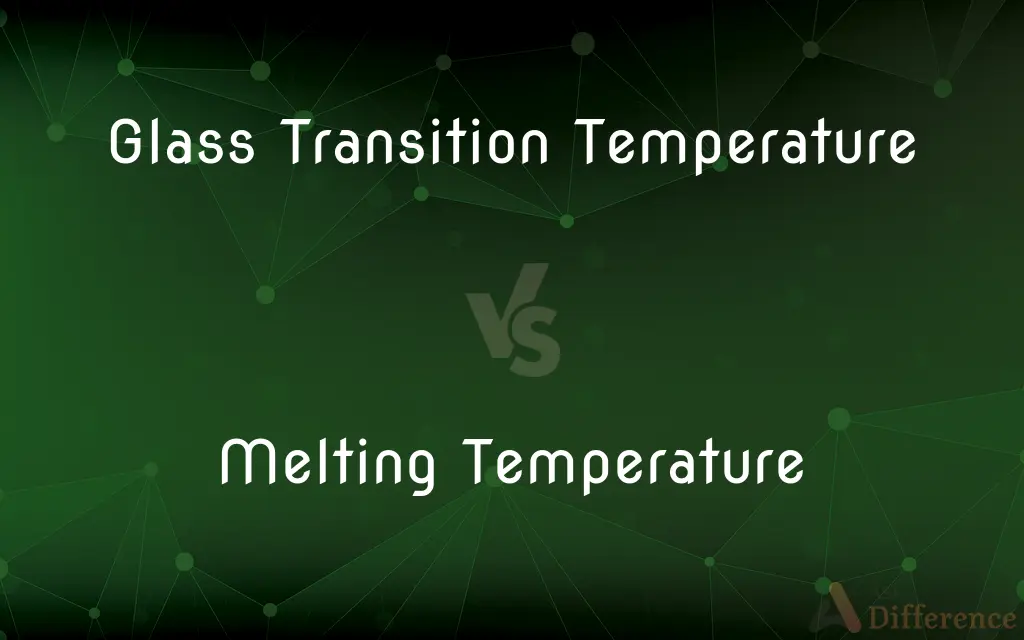Glass Transition Temperature vs. Melting Temperature — What's the Difference?
By Tayyaba Rehman — Published on October 26, 2023
Glass Transition Temperature (Tg) is the temperature at which a polymer changes from a glassy to a rubbery state without a change in crystalline structure. Melting Temperature (Tm) is the temperature at which a solid becomes a liquid.

Difference Between Glass Transition Temperature and Melting Temperature
Table of Contents
ADVERTISEMENT
Key Differences
Embarking on the exploratory path between Glass Transition Temperature (Tg) and Melting Temperature (Tm) reveals intriguing physical phenomena inherent in materials. The Glass Transition Temperature is a significant thermal threshold, determining when a polymer transitions from a brittle, glassy state to a more flexible, rubbery condition, yet without a structured phase change. On the other hand, Melting Temperature is explicit in its functional role, signaling the precise thermal point at which a solid material undergoes a phase transition, altering its physical state from solid to liquid.
Glass Transition Temperature and Melting Temperature manifest as pivotal aspects in material science, particularly when discerning the suitability of polymers and various materials in diverse applications. Tg essentially dictates the temperature at which a polymer, while not altering its phase, transitions its physical characteristics, impacting rigidity and flexibility. In contrast, Tm is inherent to all solid materials, not only polymers, determining the precise temperature at which a material transitions from a solid phase to a liquid phase, marking a definitive phase change.
While Glass Transition Temperature provides crucial insights into the flexibility and applicability of polymers under varied thermal conditions, it does not encompass a phase change, offering a range rather than a definitive point. The Melting Temperature, however, demarcates a clear, singular temperature at which a solid converts to a liquid, providing a clear, quantifiable point of phase transition, and applying universally to all solid materials, not solely polymers.
In practical applications, Glass Transition Temperature assists in identifying the operational window of polymers, indicating the thermal region within which a polymer retains desired mechanical properties without succumbing to brittleness. Conversely, Melting Temperature serves as a critical parameter in processes such as casting, molding, and welding, defining the exact temperature requisite to convert a solid into a liquid, thus facilitating various manufacturing and processing methodologies.
Conclusively, the multifaceted relevance of Glass Transition Temperature and Melting Temperature in material science and engineering underscores their imperativeness. Tg, while crucial, pertains primarily to polymers and their mechanical adaptability across temperature ranges. In stark contrast, Tm, with its broad relevance to all solids, yields absolute, critical data pertinent to material phase, thereby influencing myriad applications across material science, engineering, and manufacturing sectors.
ADVERTISEMENT
Comparison Chart
Definition
Change from glassy to rubbery state.
Change from solid to liquid state.
Involves Phase Change
No
Yes
Application to Materials
Pertains mainly to polymers.
Applies to all solid materials.
Quantifiability
Describes a range rather than a point.
Represents a specific point.
Influence on Material Characteristics
Affects flexibility and rigidity.
Transforms material phase and properties.
Compare with Definitions
Glass Transition Temperature
Influences the mechanical properties of polymers.
Above the Glass Transition Temperature, the polymer was too flexible for the application.
Melting Temperature
Applicable to all solid materials, not restricted to polymers.
The Melting Temperature of various materials is documented for reference.
Glass Transition Temperature
Dictates the temperature range of operational flexibility.
Polymers are chosen based on their Glass Transition Temperature for specific applications.
Melting Temperature
Represents a definitive phase change in a material.
The metal underwent a phase change at its Melting Temperature.
Glass Transition Temperature
Doesn't involve a change in the crystalline structure of a polymer.
The polymer maintains its structure even beyond its Glass Transition Temperature.
Melting Temperature
Integral in processes like casting, molding, and welding.
Knowing the Melting Temperature is vital for molding processes.
Glass Transition Temperature
The thermal point indicating a change from a glassy to a rubbery state.
At the Glass Transition Temperature, the polymer became flexible.
Melting Temperature
The point at which a solid transitions into a liquid.
The ice had a Melting Temperature of 0 degrees Celsius.
Glass Transition Temperature
Applies predominantly to polymers and similar materials.
Glass Transition Temperature is crucial in selecting suitable polymers.
Melting Temperature
Crucial in determining material suitability in manufacturing.
Materials are often selected based on their Melting Temperature for manufacturing processes.
Common Curiosities
Can Glass Transition Temperature be considered a range?
Yes, it's often considered a range rather than a specific point.
Does Glass Transition Temperature involve a phase change?
No, it involves a change in state but not phase.
Does Glass Transition Temperature influence mechanical properties?
Yes, it influences mechanical properties like flexibility.
Is Glass Transition Temperature relevant only to polymers?
Predominantly, yes, it's most relevant to polymers.
Is Glass Transition Temperature crucial in polymer applications?
Yes, it indicates operational flexibility of polymers.
Is the Melting Temperature the same for all materials?
No, different materials have different Melting Temperatures.
Does Melting Temperature indicate a specific temperature?
Yes, it indicates a specific temperature where solid turns to liquid.
Does Glass Transition Temperature affect a material’s flexibility?
Yes, it affects the transition from rigidity to flexibility.
Is Melting Temperature applicable to all materials?
Yes, Melting Temperature applies to all solid materials.
Is Melting Temperature important in manufacturing processes?
Yes, it’s vital for processes like casting and molding.
Is Melting Temperature a critical factor in material selection?
Yes, it influences selection for various applications.
Is Melting Temperature vital for determining a material’s phase?
Yes, it determines the transition from solid to liquid phase.
Can Glass Transition Temperature dictate polymer usability?
Yes, it can determine where a polymer can be effectively used.
Does Glass Transition Temperature impact material brittleness?
Yes, below Tg, polymers tend to be more brittle.
Does the Melting Temperature impact material properties?
Yes, it impacts properties like density and viscosity.
Share Your Discovery

Previous Comparison
Fudge vs. Cake
Next Comparison
Mustard Oil vs. Canola OilAuthor Spotlight
Written by
Tayyaba RehmanTayyaba Rehman is a distinguished writer, currently serving as a primary contributor to askdifference.com. As a researcher in semantics and etymology, Tayyaba's passion for the complexity of languages and their distinctions has found a perfect home on the platform. Tayyaba delves into the intricacies of language, distinguishing between commonly confused words and phrases, thereby providing clarity for readers worldwide.












































